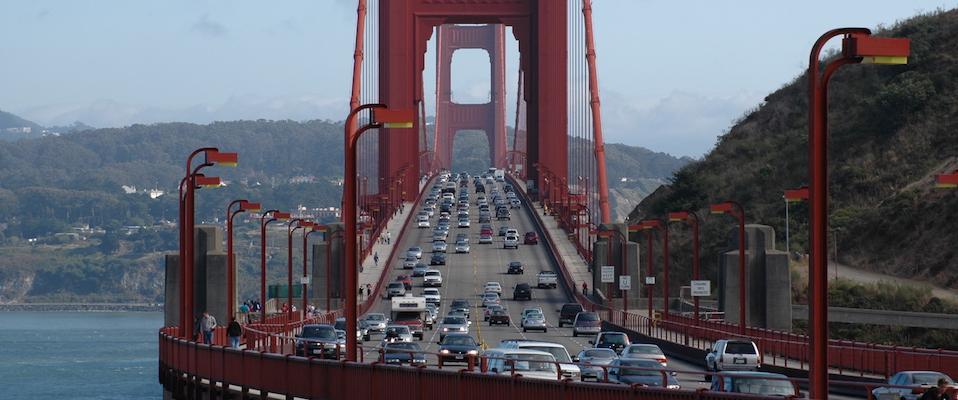Road rage is hardly an acceptable response to the travails of driving. It signals inadequate impulse control, perhaps even sociopathy. People can end up hurt, incarcerated, or worse.
But how about road woe? Because it’s probably one reaction or the other: If the Bay Area’s freeways don’t make you rage, they’ll at least make you weep. And since a recent Metropolitan Transportation Commission report found that “congested delay”—traffic moving at 35 mph or less—has increased 70 percent in the Bay Area since 2010, it’s an understanding reaction. Bay Bridge traffic is now officially “congested” from 5:35 a.m. to 7:50 p.m. The westbound I-80 corridor from the Highway 4 terminus in Hercules to Highway 101 in San Francisco is now gridlocked for most daylight hours.
From one perspective, the hellish congestion seems inevitable; geography, economic forces, and the culture all demand it. San Francisco and the East Bay constitute a relatively small and discrete area, hemmed in by mountains, bay and ocean. Lots of people want to live here, drawn by good jobs, fabulous restaurants and abundant recreational opportunities. And of course, being Americans—more specifically, being Californians—we don’t want to give up our cars. Bottom line: Gridlock without end, amen.
But the U.S. Department of Transportation thinks it doesn’t have to be that way, and they’ve kicked $11 million to UC Berkeley and the City of San Francisco to prove it. The money will be used to fund several traffic congestion reduction projects in the Bay Area: New HOV lanes, the deployment of smart “multi-modal traffic signal systems” to increase public transit speeds, development of an autonomous shuttle system for Treasure Island that could ultimately be deployed regionally and nationally, designation of special carpool pick-up curbs, and creation of an improved toll system.
“It’s not a hopeless situation,” says Susan Shaheen, a Cal adjunct professor of civil and environmental engineering, the co-director of Berkeley’s Transportation Sustainability Research Center, and the university’s point person for the Department of Transportation Initiative.
“There are a broad range of strategies you can use to reduce congestion,” Shaheen says, “both technological and non-technological. They range from pricing—such as bridge tolls and toll roads—to augmented mass transit systems and carpooling incentives.”
Pricing schemes are tempting because they’re simple: Jack up bridge tolls and charge motorists a pretty penny to use certain lanes or roads at certain times of the day. Such approaches can be highly effective, says Shaheen, “but they’re also regressive. The impacts on low income people are disproportionately high, so they must be implemented very cautiously.”
Shaheen says carpooling has great potential for reducing congestion. But she’s not talking about your grandpa’s carpooling: basic office carpools, or people picking up casual carpoolers at parking lots. (Well, that is part of it, but just a part.) The smart phone has changed everything, she says, and its potential has by no means been realized fully. Smart phones can be used to tap into broad carpooling networks, and commercial carpooling ventures involving “e-hailing” services such as Uber and Lyft are starting to take off. They must be further encouraged, Shaheen says.
Pending improvements to BART and the soon-to-be-completed SMART system—a passenger train and bicycle pathway connecting Sonoma County to Marin—also are encouraging developments, but they won’t be fully realized unless efforts are made to get people quickly and efficiently from their homes and offices to mass transit hubs, Shaheen says.
“You can save $300 to $400 a month or more by shifting away from car ownership, and our research indicates that people are shifting away,” says Cal prof Susan Shaheen. “The more they interface with alternative transportation services, the more willing they are to forego car ownership.”
“Effective mass transit and traffic reduction means thinking through every component of possible responses,” Shaheen says. “It’s not enough to just expand options from city to city, or from the suburbs to the urban centers. We also have to provide alternatives other than cars for people who need to get to a BART or rail station. Again, that could be private car e-hailing services, or micro-transit shuttle services like Chariot, which, like Uber and Lyft, grant you access through your smart phone. We also need to improve our HOV system, develop autonomous shuttle systems, expand private car sharing, provide more and better bicycle and pedestrian routes, think about bike sharing programs. In short, we have to develop a full ecosystem of transit services that makes it easier for people to get out of their cars.”
Finally, snarled and unending traffic may prove part of the solution to, well, snarled and unending traffic.
“Congestion itself is a disincentive to drive and an incentive for seeking other options,” says Shaheen. “Another disincentive is the fixed burdens of auto ownership: The cost of the car, insurance, fuel and maintenance, parking. You can save $300 to $400 a month or more by shifting away from car ownership, and our research indicates that people are shifting away. The more they interface with alternative transportation services, the more willing they are to forego car ownership. It’s a classic case of suppression effect—access to alternative services is starting to suppress the desire to own a car, at least in areas with serious traffic congestion. And as access to on-demand mobility via smart phone increases, we expect to see that trend accelerate.”




















